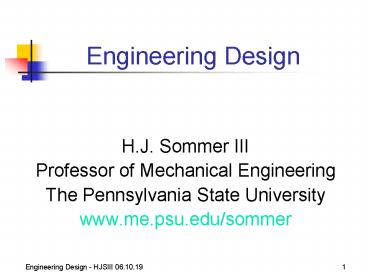Engineering Design - PowerPoint PPT Presentation
1 / 21
Title: Engineering Design
1
Engineering Design
- H.J. Sommer III
- Professor of Mechanical Engineering
- The Pennsylvania State University
- www.me.psu.edu/sommer
2
Fundamental Principlesof Design
- Design requires clear objectives
- Design requires creativity
- Design requires evaluation
- Design requires communication
3
Em c2
- E effectiveness of an engineer
- m mastery of technical issues
- c communication skills
4
The Design Process
- 1) Recognize the need
- 2) Define the problem (not a solution)
- 3) Plan the project
- 4) Collect information
- 5) Formulate alternative concepts
5
The Design Process
- 6) Evaluate alternatives
- 7) Optimize alternatives
- 8) Select the best alternative
- 9) Communicate the design
- 10) Implement the design
6
Design is iterative
- Be ready to revisit any prior steps in the process
7
1) Recognize the need
- Market assessment
- Customer feedback
- Request for proposal (RFP)
8
Need statement
- Often expresses dissatisfaction with the current
situation - Negative emphasis contrasts with positive future
goal - Should never present a solution looking for a
problem
9
2) Define the problem(not a solution)
- Goal statement
- Objectives (quantifiable measures)
- Constraints (permissible envelopes)
10
Goal statement
- Brief general ideal response to the need
- Refined by objectives
- Allows alternative solutions
11
Objectives
- Quantifiable expectations of performance
- Specify operating conditions
- Specify evaluation criteria if possible
12
Constraints
- Permissible envelopes for objectives
- Permissible envelopes for design features
- Conform to industry, professional and regulatory
standards
13
3) Plan the project
- Temporal milestones
- Performance milestones
- Deliverables
- Timeline
- Budget
14
4) Collect information
- Assumptions
- Data
- Institutional knowledge
- Standards
15
5) Formulate alternative concepts
- Modify
- Redesign
- Reverse engineer
- Brainstorm
- Observe
- Unrelated products
- Nature
16
6) Evaluate alternatives
- Consistent metrics
- Prototype
- Computational models
- Manufacturability and assembly
- Life-cycle
17
Life-cycle assessment
- Raw materials
- Components and subassemblies
- Product
- Packaging and distribution
- Customer
- Repair
- Recycle and discard
18
7) Optimize alternatives
- Computational optimization
- Iterative prototype testing
- Competing teams
19
8) Select the best alternative
- Group decision
- Customer based
- Chief Engineer
- Ongoing iterative design with your customer
in-the-loop
20
9) Communicate the design
- Proposal
- Preliminary Design Review
- Final Design Review
21
10) Implement the design
- Should not cause trepidation if you follow the
process, iterate and communicate































